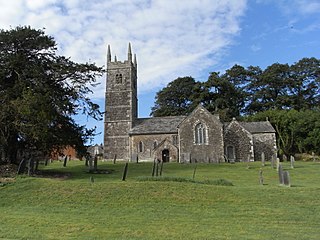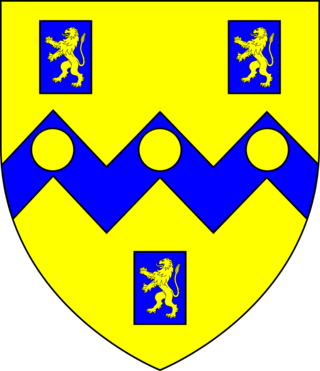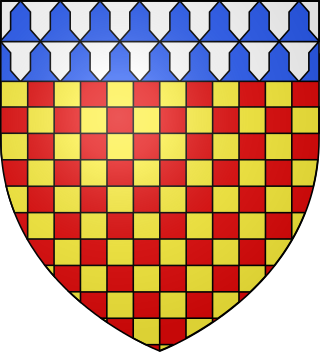
Cadhay is an historic estate in the parish of Ottery St Mary in Devon, England, 10 miles (16 km) east of Exeter and 5 miles (8 km) from the sea at Sidmouth. The mansion house known as Cadhay House, 1 mile (2 km) north-west of Ottery St Mary village, is a grade I listed Elizabethan building.

Tetcott is a civil parish, small settlement and former manor in Devon, England. The parish lies about five miles south of the town of Holsworthy and is bordered on the north by the parish of Clawton, on the east by a small part of Ashwater, and on the south by Luffincott. It forms part of the local government district of Torridge, and its western boundary is the River Tamar which forms the Cornish border. In 2001 its population was 110, half that of a century earlier.

John Arundell, of Trerice in Cornwall, was a Member of Parliament for Mitchell, Cornwall, in 1555 and 1558, and was High Sheriff of Cornwall in 1573–1574.

Sir John Rolle, KB, of Stevenstone, Devon, was an English landowner, Sheriff of Devon in 1682 and MP for Barnstaple (1660) and for Devon (1661–1679). The Travel Journal of Cosimo III de' Medici, Grand Duke of Tuscany (1642-1723) states of him: "This gentleman is one of the richest in the country, having an estate of six thousand pounds sterling per annum, besides a considerable property in ready money".

Sir John Chichester of Raleigh in the parish of Pilton, near Barnstaple in North Devon, was a leading member of the Devonshire gentry, a naval captain, and ardent Protestant who served as Sheriff of Devon in 1550-1551, and as Knight of the Shire for Devon in 1547, April 1554, and 1563, and as Member of Parliament for Barnstaple in 1559, over which borough his lordship of the manor of Raleigh, Pilton had considerable influence.

Hon. Mark George Kerr Rolle, of Stevenstone, St Giles in the Wood, Devon, was High Sheriff of Devon in 1864, a DL of Devon and High Steward of Barnstaple.
The surname Denys was borne by at least three prominent mediaeval families seated in Gloucestershire, Somerset and Devon in southwest England between 1166 and 1641. It is not known if any relationship existed between these families. The surname Denys is just one of many variant spellings of the name: Denise, Le Deneis, Le Danies, le Deneys ,and most recently Dennis, are some of the others.

Holcombe Rogus is a historic manor in the parish of Holcombe Rogus in Devon, England. The present grade I listed Tudor manor house known as Holcombe Court was built by Sir Roger Bluett c. 1540 and was owned by the Bluett family until 1858 when the estate was sold to Rev. William Rayer. The house is immediately to the west of the parish church. The gardens and grounds are screened off from the public road at the south by a high wall in which is a tall and broad entrance archway which forms the start of the entrance drive.

The historic manor of Raleigh, near Barnstaple and in the parish of Pilton, North Devon, England, was the first recorded home in the 14th century of the influential Chichester family of Devon. It was recorded in Domesday Book of 1086 together with three other manors that lay within the later-created parish of Pilton. The manor lies above the River Yeo on the southern slope of the hill on top of which stand the ruins of the Anglo-Saxon hillfort called Roborough Castle. Part of the historic manor of Raleigh is now the site of the North Devon District Hospital.

Sir Thomas Denys of Holcombe Burnell, near Exeter, Devon, was a prominent lawyer who served as Sheriff of Devon nine times between 1507/8 to 1553/4 and as MP for Devon. He acquired large estates in Devon at the Dissolution of the Monasteries.
John Northcote (1570–1632) of Uton and Hayne, Newton St Cyres, near Crediton, Devon, was a member of the Devonshire gentry, lord of the manor of Newton St Cyres, who is chiefly known to history for his artistically acclaimed effigy and monument in Newton St Cyres Church. Little or no documentary evidence concerning his career as a soldier or county administrator has survived, but either he or his identically named son was Sheriff of Devon in 1626.

Sir Robert Dennis, JP of Holcombe Burnell in Devon, was a Member of Parliament for Devon in 1555 and served as Sheriff of Devon.

Denys Rolle (1614–1638) of Bicton and Stevenstone in Devon was Sheriff of Devon in 1636. He was one of the biographer John Prince's Worthies of Devon.

The estate of Acland in the parish of Landkey, near Barnstaple in North Devon, England, was from 1155 the earliest known seat of the influential and wealthy family of Acland, to which it gave the surname de Acland. It is situated about 3/4 mile north-east of the village of Landkey, from which it is now cut off by the busy A361 North Devon Link Road.

Great Fulford is an historic estate in the parish of Dunsford, Devon. The grade I listed manor house, known as Great Fulford House, is about 9 miles west of Exeter. Its site was said in 1810 to be "probably the most ancient in the county". The present mansion house is Tudor with refurbishment from the late 17th century and further remodelling from about 1800. The prefix "Great" dates from the late 17th century and served to distinguish it from the mansion house known as "Little Fulford" in the parish of Shobrooke, Devon, about 8 miles to the north-east, also owned briefly by Col. Francis Fulford (1666–1700), as a result of his marriage to the heiress of the Tuckfield family. Great Fulford has been the residence of the Fulford family, which took its name from the estate, from the reign of King Richard I (1189–1199) to the present day. There are thus few, if any, families in Devonshire of more ancient recorded origin still resident at their original seat. In 2004 the estate comprised 3,000 acres.

Kittisford is a historic manor near Wellington in Somerset, England. It is situated on the River Tone, south of the village of Bathealton. The surviving manor house is called Kittisford Barton, situated formerly within the historic parish of Kittisford, now amalgamated into the parish of Stawley. It was built in the late 15th or early 16th century. It is a Grade II* listed building.

Sir John Chichester lord of the manor of Raleigh in the parish of Pilton, near Barnstaple, North Devon, was Sheriff of Devon in 1576/7 and/or in 1585 and died of gaol fever contracted whilst acting as a magistrate at the Lent Black Assizes of Exeter in 1586.
The recorder of Exeter was a recorder, a form of senior judicial officer, usually an experienced barrister, within the jurisdiction of the City of Exeter in Devon. Historically he was usually a member of the Devonshire gentry. The position of recorder of any borough or city carried a great deal of prestige and power of patronage. The recorder was often entrusted by the mayor and corporation to nominate its members of parliament, as was the case with Sir Hugh I Pollard, Recorder of Barnstaple, who in 1545 nominated the two MP's to represent the Borough of Barnstaple. In the 19th century a recorder was the sole judge who presided at a Quarter Sessions of a Borough, a "Court of Record", and was a barrister of at least five years' standing. He fixed the dates of the Quarter Sessions at his own discretion "as long as he holds it once every quarter of a year", or more often if he deemed fit.

Speccot is an historic estate in the parish of Merton in Devon, England. It was the seat of the de Speccot family, one of the oldest gentry families in Devon, which founded almshouses at Taddiport, near Great Torrington, Devon, in the 13th century. It is situated about one mile south-west of Potheridge, the seat of the Monck family from before 1287 to the late 17th century, who were thus close neighbours of the de Speccot family for many centuries. The present farmhouse known as "Speccot Barton" is Victorian and although no obvious traces of an earlier house survive, is marked "On Site of a Mansion" on the First Edition Ordnance Survey 25 inch map of 1880-99. The estate is today operated as a family-run sheep farm with six holiday cottages to let. A smaller house known as "Little Speccot" is situated on the approach lane to Speccot Barton.

Weycroft is an historic manor in the parish of Axminster in Devon, England. The surviving manor house known as "Weycroft Hall" is a Grade I listed building which includes elements from the 15th, 16th and 17th centuries, with a great hall of circa 1400, and was restored in the 19th century.


















